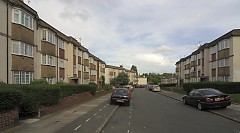|
A mixed settlement of council and private housing, separated by the railway line from the Downham estate to the south-west.
This was dense woodland in the extreme south of the parish of Lee until the early 18th century. At that time, as local historian
John King puts it, Grove Park ‘just did not exist, in name or reality.’ Thereafter, the trees were cut down and
mostly used to make charcoal, hence the name of Burnt Ash Farm, which covered most of the area. A smaller farm, near present-day
Somertrees Avenue, was called Grove Farm. A short-lived brickworks operated in the mid-19th century and some of its bricks
were used locally to build a number of large houses. In the early 1870s a station was built and a road was constructed to
provide a link to Mottingham, and both were named Grove Park, after the farm. Throughout the rest of the century a handful
of villas went up annually. In 1902, the Greenwich workhouse was built here. It served as a barracks during World War I and
became a tuberculosis isolation hospital in 1926. In the same year the railway line was electrified and Lewisham council began
building its 44-acre Grove Park estate. The council bought Chinbrook Meadows for use as a recreation ground. Sports grounds
and private housing consumed Grove Park’s remaining dairy pasture and plant nurseries in the 1930s, although a pig and
poultry farm was subsequently established for wartime purposes. This survived until the construction of the Marbrook estate
in the 1960s, which followed a number of smaller infill projects designed to address the post-war housing shortage. Private
housebuilding has continued to the present day, including the redevelopment of the former Grove Park hospital site.
 |

